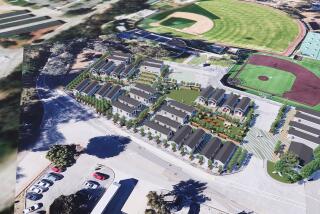Crystal Cove Residents Must Move by Year’s End : Development: State will not extend leases. Officials plan to rehabilitate bungalows for short-term rental.
CRYSTAL COVE — Despite a letter-writing campaign and a plea from Assemblywoman Marilyn C. Brewer, state officials said Friday they won’t extend the Dec. 31 deadline for residents to leave the tiny beachfront community of Crystal Cove State Park, which officials plan to renovate for public use.
“It is necessary to have the area vacated so the work can proceed,” said Chris Chrystal, an aide to the state secretary for resources. “So I don’t think they’re inclined to have another delay.”
Brewer (R-Irvine) had asked the state Thursday to consider allowing residents to remain in their cottages until firm plans are in place to rehabilitate the community’s historic beachfront bungalows.
“She is asking [for] a month-to-month extension,” said Stacy Leff, Brewer’s aide. “That would be a good compromise, because the evictions, she believes, were premature unless the state had a confirmed plan for the land.”
Residents received notices from the California Department of Parks and Recreation early this month that they must move by Dec. 31. The state, which bought the property from the Irvine Co. in 1979 for about $33 million, plans to renovate the 45 beach houses and rent them to the public for short-term stays.
Hoping for a reprieve, residents launched a letter-writing campaign that caught Brewer’s attention.
“We’re doing everything we can to preserve our homes,” said Al Willinger, a member of the Crystal Cove Residents Assn.’s executive committee. “No different than any homeowner would do.”
Members of the cloistered community, tucked between the ocean and Coast Highway and between Laguna Beach and Corona del Mar, know they must move eventually but want to stay as long as possible in their bungalows, which in some cases have been occupied by the same family for five generations, Willinger said. About half of the cottages are occupied by full-time residents, he said.
“They want to vacate it when all the permits have been issued and the project is a go. And we estimate that, from our knowledge, to be two to three years downstream, if everything goes well,” said Willinger, a former full-time resident who now uses his cottage as a second home. “This is a very emotional subject, because of the span of generations. . . . They’re not ready to quit fighting till the last possible moment.”
In her letter to Resources Secretary Douglas P. Wheeler, Brewer endorsed the state’s plan to convert Crystal Cove for public use but asked the agency to consider allowing the tenants to stay there at least through March.
She questioned the wisdom of relinquishing the lease payments from the residents, which amount to $500,000 annually, until the state has a solid development plan in hand.
“It is not economically feasible for the state not to have that revenue stream,” Leff said.
The assemblywoman also is concerned about what will happen to the historically valuable cottages if they are vacant indefinitely and vulnerable to vandalism, Leff said, a concern shared by the residents.
But Bob Cates, chief of the Department of Parks and Recreation’s Environmental Design Division, which is managing the project, said Friday he still expects the cottages to be empty by year’s end.
Although the state will lose the lease payments, Cates said, development plans can proceed more smoothly once the bungalows are vacant.
“It is the cost of doing business, basically,” Cates said. And park rangers who already patrol the area will help prevent vandalism, he said.
The state first tried to evict Crystal Cove residents shortly after it bought the land. But they managed to stay through legal wrangling and lease extensions. The most recent lease, which residents signed 2 1/2 years ago, calls for them to move by Dec. 31.
There is considerable work to be done at the site, including installing new sewer and water lines. While he does not know when construction will begin, Cates said he expects to have a workable development proposal in place by about mid-May.
“Our objective is to open it up to full public use as opposed to exclusive use of the tenants down there now,” he said. “That’s one of the reasons the property was acquired.”
More to Read
Sign up for Essential California
The most important California stories and recommendations in your inbox every morning.
You may occasionally receive promotional content from the Los Angeles Times.









